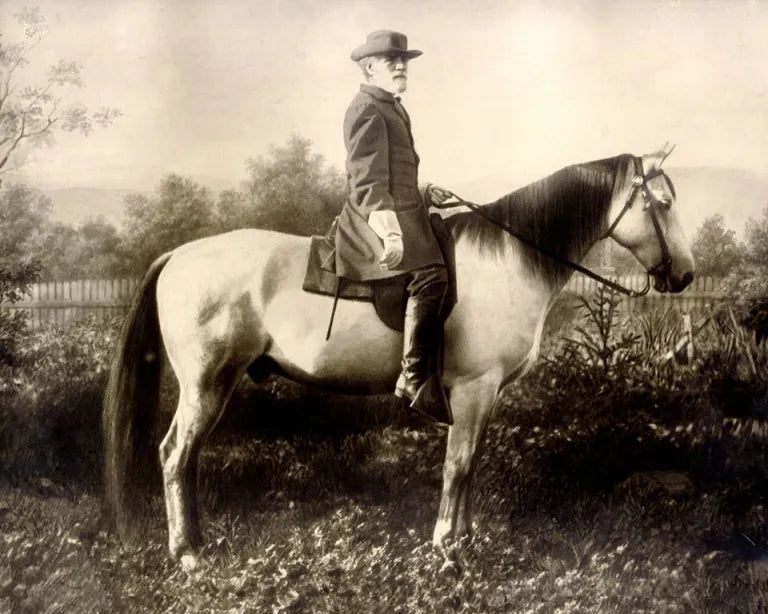
General Robert E. Lee has long been a part of Virginia’s history. After the War Between the States, he accepted a position as president of Washington College, which was later named Washington and Lee University in his honor. The general is buried in the chapel on campus, even though the Confederate flags around his chamber have been removed.
General Lee’s beloved horse, Traveller, is buried just outside the chapel. Up until last week, there was a marker denoting Traveller’s gravesite, but the marker has been removed. The plaque had been a part of the university’s fabric since 1930, when it was decided that Traveller’s remains required a proper burial. Prior to that, the skeleton was on display, and students etched their initials into the bones for good luck. It has been a longstanding tradition for students and faculty to leave treats on Traveller’s gravesite.
But now, the plaque is gone, as well as two other plaques on campus referring to General Lee. University officials didn’t bother to make any prior announcements about the desecration. Lynn Rainville, the Director of Institutional History and Museums, is the person directly responsible for the removal of Traveller’s plaque. Contact her at the following address, and let her know this is not okay. She should not be the one deciding the fate of our history.
Washington and Lee University
Attention: Lynn Rainville
204 W. Washington Street
Lexington, Virginia 24450
Telephone: 540-458-8379
Here is an excerpt from my book, Horses in Gray, which describes the beautiful horse, Traveller.
Behold that horse! A dappled gray!
I saw him in the month of May,
When wild flowers bloomed about his feet,
And sunshine was his mantle meet.
Of all the horses to serve in the War Between the States, the most famous is Traveller. The magnificent steed and his owner, General Robert E. Lee have become synonymous in history. Although Traveller was not the only horse Lee owned, he was certainly the general’s favorite. The two were constant companions.
… Traveller has also been immortalized in verse, such as in the following by Stephen Vincent Benet:
And now at last, comes Traveller and his master. Look at them well. The horse is an iron-grey, sixteen hands high, Short back, deep chest, strong haunch, flat legs, small head, Delicate ear, quick eye, black mane and tail, Wise brain, obedient mouth. Such horses are the jewels of the horseman’s hands and thighs, They go by the word and hardly need the rein. They bred such horses in Virginia then, Horses that were remembered after death And buried not so far from Christian ground That if their sleeping riders should arise They could not witch them from the earth again And ride a printless course along the grass With the old manage and light ease of hand.
… Before his death, General Lee was approached by his wife’s cousin, Martha “Markie” Williams, who desired to paint a portrait of Traveller. In response, the general dictated a description to his daughter, Agnes: “If I were an artist like you, I would draw a true picture of Traveller . . . Such a picture would inspire a poet, whose genius could then depict his worth and describe his endurance of toil, hunger, thirst, heat, cold, and the dangers and suffering through which he passed. He could dilate upon his sagacity and affection, and his invariable response to every wish of his rider. He might even imagine his thoughts, through the long night marches and days of battle through which he has passed.
“But I am no artist. I can only say he is a Confederate gray. I purchased him in the mountains of Virginia in the autumn of 1861, and he has been my patient follower ever since—to Georgia, the Carolinas, and back to Virginia. He carried me through the Seven Days battle around Richmond, the second Manassas, at Sharpsburg, Fredericksburg, the last day at Chancellorsville, to Pennsylvania, at Gettysburg, and back to the Rappahannock.
“From the commencement of the campaign in 1864 at Orange till its close around Petersburg, the saddle was scarcely off his back, as he passed through the fire of the Wilderness, Spotsylvania, Cold Harbor, and across the James River. He was almost in daily requisition in the winter of 1864-65 on the long line of defenses from the Chickahominy, north of Richmond, to Hatcher’s Run, south of the Appomattox. In the campaign of 1865, he bore me from Petersburg to the final days at Appomattox Court House.
“You must know the comfort he is to me in my present retirement. He is well supplied with equipments. Two sets have been sent to him from England, one from the ladies of Baltimore, and one was made for him in Richmond; but I think his favorite is the American saddle from St. Louis.
“Of all his companions in toil, Richmond, Brown Roan, Ajax, and quiet Lucy Long, he is the only one that retained his vigor. The first two expired under their onerous burden, and the last two failed.
“You can, I am sure, from what I have said, paint his portrait.”

Grave of Robert E. Lee's Horse Desecrated, Plaque to Beloved Traveller Removed
Washington and Lee University (W&L) recently struck another giant blow for racism with the removal of the memorials of one of the nation’s most racist animals — Traveller, the notorious … Continue reading

